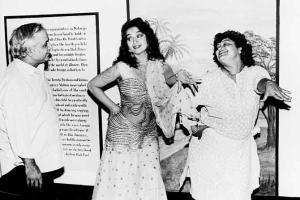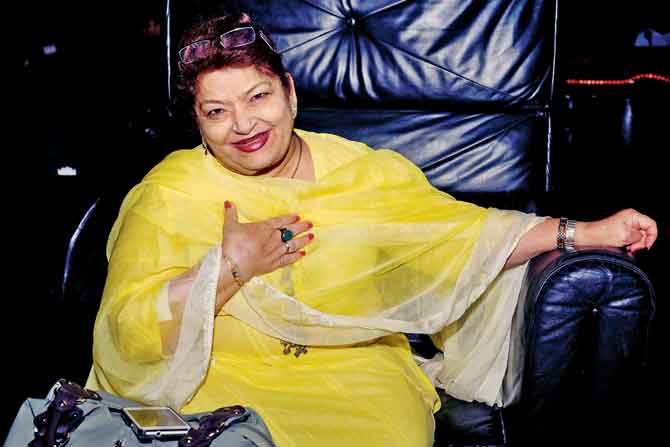saroj Khan had been around in the film industry ever since she was a three-year-old child actor.

Saroj Khan with Madhuri Dixit
Soon after the premiere of Sanjay Leela Bhansali's Devdas (2002) at New Excelsior cinema, both Bhansali and the leading-lady Aishwarya Rai drove off together to meet the film's choreographer Saroj Khan. Khan had been unwell even during the shoot of Devdas. But her health had deteriorated considerably since, and she'd been admitted to the ICU.
Bhansali told her they'd come straight from the premiere. As a colleague, Bhansali found Saroj Khan to be "temperamental, expressive, wild, 100 watt!" That night, dazed under heavy medication, barely able to open her eyes, let alone say hello, she still excitedly mumbled from bed: "Gaane pe seeti baji ki nahin! Paise ude ki nahin? [Did the audiences whistle, throw money at the songs!]"
I'm referring to Devdas's Indian first night. The world premiere of course took place at a special/gala screening — celebrating Hindi cinema, peacocking in full splendour — at Cannes that year. Call it India's growing soft-power, if you will, this was unusual for the world's top film festival at the time.
ADVERTISEMENT
"Of course, there's more to Bollywood than just song and dance" — you can cry hoarse, tackling that common put-down among ignoramuses abroad. The fact is, there is nothing else globally unique about our cinema either. By which I mean traditional music, choreography that exist in movies, simply to lift moods, moments, or indulge in generic emotions alone. Unlike the sample western musical, where songs, dances must necessarily take the story forward.
Sure much has changed. Sepia-toned history of Hindi films is still best relived by visuals of heroes and heroines prancing on screen — Dharmendra, Hema Malini, Dev Anand, Waheeda Rehman…. Or, better still, dreaming about Helen. Everybody worships the dancing Helen.
I'll be a rich man collecting a buck each from her fans who have never even heard of PL Raj — the man behind Helen's cabaret moves; besides sensational steps in Sholay (1975), including Mehbooba mehbooba. Just the same, if I asked you to name the dance-director of the iconic Guide (1965).
That was B Sohanlal, his name suffixed with "South", because he was from Madras, and prefixed with Master because that's what choreographers were called.
And you were never supposed to hear about them (despite film credits like Madhumati, Sahib Bibi Aur Ghulam, Sangam). Because, who cares?
Sohanlal's dancing protégé Nirmala Kishenchand Nagpal changed that about her profession. Everybody knew Nirmala — as "Masterji" on set, and by her screen-name Saroj Khan otherwise. By sheer dint of her status/popularity within the film industry, seguing into high public-recall, Saroj Khan (always one word) did to choreography, what Manish Malhotra perhaps did to costume designing later, or Avan Contractor to hair-styling.
Give a profession a name first — among aam janta —and maybe also put a face to it. Nobody messes with you after. Much like what Salim-Javed pulled off for screen-writing in the '70s. That's a bigger legacy to leave behind, than simply one's private success. It helps those who follow.
As it did Farah Khan, who gained much currency from choreographing songs with more western sensibilities in films (Jo Jeeta Wohi Sikandar, Dilwale Dulhania Le Jayenge) where Saroj Khan was already the main choreographer. Farah was the new style/voice. And that is premised only on the acknowledgement of an existing one.
Saroj Khan had been around in the film industry ever since she was a three-year-old child actor. She'd been a background dancer since she was around 9. She passed away at 71. Off and on she had been in the film industry for 68 years — fair portion of it, by all accounts, spent in pain, dealing with personal issues, deaths, separations, and ignominy, actually.
She'd had a series of "breaks" in her career as well — starting with Pratigya (1975), the mainstream Dharmendra movie, where she was hired as chief choreographer; or Jazbaat (1980), which was a Rajshri film, no less; or Subhash Ghai's Hero (1983), a full-on blockbuster, indeed.
So what really changed things for her and the scene? I suspect the gradual phasing out of the '80s blood-thirsty revenge actioners, making way for more musical romances by the turn of that decade. There was also a fresh constellation of female stars on the horizon, for her to polish and push her talent through: Karisma Kapoor, Rani Mukerji, Kareena Kapoor… But chiefly, Madhuri Dixit.
And the song Ek do teen in N Chandra's Tezaab (1988). While it was common for songs to be picturised in seated auditoriums and posh cabarets, Chandra says this was the first track with the wild energy of the public standing and dancing like they're gonna take their clothes off in excitement. Madhuri's steps made this response believable. This was shortly after Saroj Khan's Hawa hawaii that made Sridevi an even bigger sensation with Mr India (1987).

Filmfare apparently couldn't ignore this contribution anymore, and instituted for the first time an award for Best Choreography. Whether Tezaab had everything to do with it, the first black lady for dancing in 1989 did go to Saroj Khan. And the hat-trick — for 1990 (Chalbaaz), 1991 (Sailaab); then 1993 (Beta), 1994 (Khal Nayak). Phew!
Growing up in the '90s, the first other dance-director I'd heard of was Chinni Prakash! This was specifically in context to Bachchan's pumping-fists, gyrating-hips steps in Jumma chumma for Hum (1991). And that's only because it was seen as answer to Saroj Khan's stamping of the feet moves in Tamma tamma for Thanedaar (1990). Both songs simultaneously copied from Mory Kante's Yeke yeke!
Hey, she got Sanjay Dutt to dance, saala. That deserves a prize of its own, although Chinni Prakash's choreography still inspires Indian men to take on the dance floor. Jhumma chumma is the song you're most likely to see desi boys of varying vintage get together for that mandatory performance on stage, for their friend's wedding 'sangeet'.
What do the women do? Often show off their Saroj Khan steps rehearsed over weeks for the big day — Mehandi laga ke rakhna (DDLJ), Nimbooda (Hum Dil De Chuke Sanam), Dola re dola (Devdas), Yeh ishq haaye (Jab We Met), Mera piya ghar aaya (Yaarana), Radha kaise na jale (Lagaan)…
Like surely many others on Facebook/Instagram, I'm seeing my friend post/boast about her Saroj Khan dance from her own wedding, to the track Mehndi hai rachnewali (Zubeidaa), the same one playing in Nidhi Tuli's must-watch, first-rate documentary The Story of Saroj Khan (where I've quoted Bhansali and Chandra from). The sangeet is an Indian wedding function, wholly ritualised from '90s Bollywood. Pretty sure it has no pan-India basis in tradition. It did not exist before. And not to this obsessive extent anyway.
Bollywood is globally a dance style, even before a film genre. What does it entail? Basically the trademarked moves and tunes Saroj Khan made her actresses dance to — a mix of folk and Indian classical, chiefly kathak. Every traditional Hindi film heroine (notably Katrina Kaif) has enrolled in hardcore kathak classes, before joining films. It's probably the long-established equivalent of horse-riding for heroes in Bollywood.
But that's not all. I suspect a lot of the dance movements have to do with facial acting — the camera is fixed on the pretty face — or 'ada', as they call it. You only have to watch the Saroj Khan composition Maar daala (Devdas), where Madhuri literally has a different facial expression for every note in the song, to get the seductive sense.
Exuding sheer temptress- like qualities, as it were. Things might seem subtler in Bollywood, but if you scrolled casually at gestures and faces made by millions of desi girls on the Chinese social-media app that got banned this week, you'd totally appreciate how Saroj Khan is hands down patron deity of the TikTok generation!
And yet, up until Saroj Khan, choreography in Bollywood was considered a man's job! And boy did she change that. Rocked it like a hurricane. What was her most famous song from the '90s? Pretty sure Choli ke peeche kya hai. It was, I'm told, one of the first Hindi songs to play at Ghungroo, the posh night-club in Delhi, which was gradually getting okay with playing 'Bollywood' in the country it's from. Not so the case with Bombay, for years after.
Now you could have issues with the double-meaning lyrics of Choli ke peeche. There was quite a drama around the time. Pretty sure the unapologetic Saroj Khan was unfazed by the moralists. Only a couple of years earlier, director Inder Kumar had taken her along to the Censor Board office for the preview screening of Beta (1991).'
A lady in the Censor Board had raised objection to Madhuri's heaving chest moves in the song Dhak dhak karne laga. "She is doing it deliberately," the lady complained, moving her chest, that is. Saroj Khan asked the Censor Board member to get up, and walk a few steps. The lady did.
She said, "Look, your bum is shaking deliberately, sideways [because of high heels]. In a dance, we have to show (accentuate) more. And we're talking about heart, it's by the bust-line, can't make the bum move for it." The Censor Board member, surely baffled, was convinced, nonetheless. She let the song go, untouched. Tried best to avoid the cliché; but, no, this really is the end of an era.
Catch up on all the latest entertainment news and gossip here. Also, download the new mid-day Android and iOS apps.
Mid-Day is now on Telegram. Click here to join our channel (@middayinfomedialtd) and stay updated with the latest news
 Subscribe today by clicking the link and stay updated with the latest news!" Click here!
Subscribe today by clicking the link and stay updated with the latest news!" Click here!







